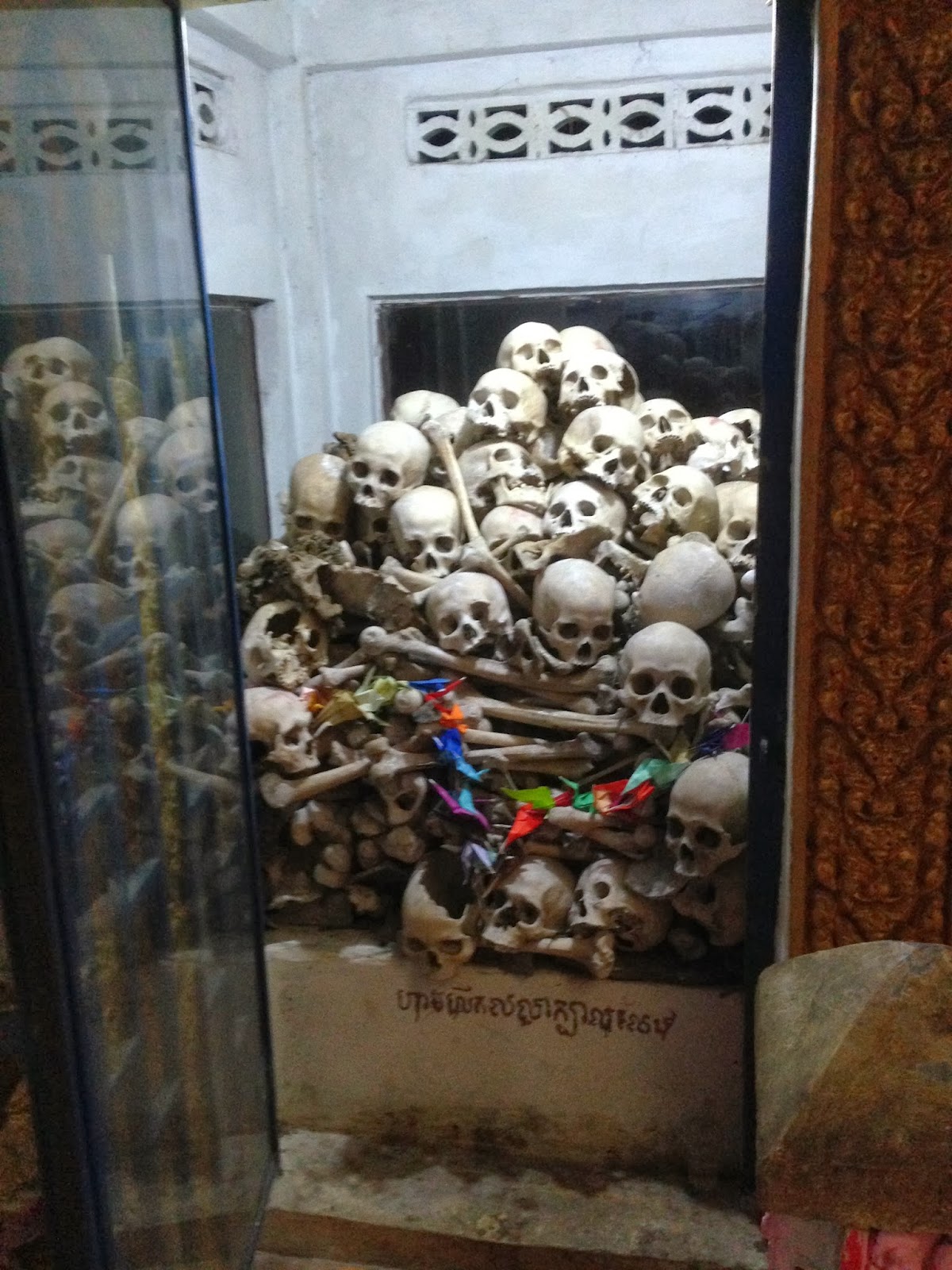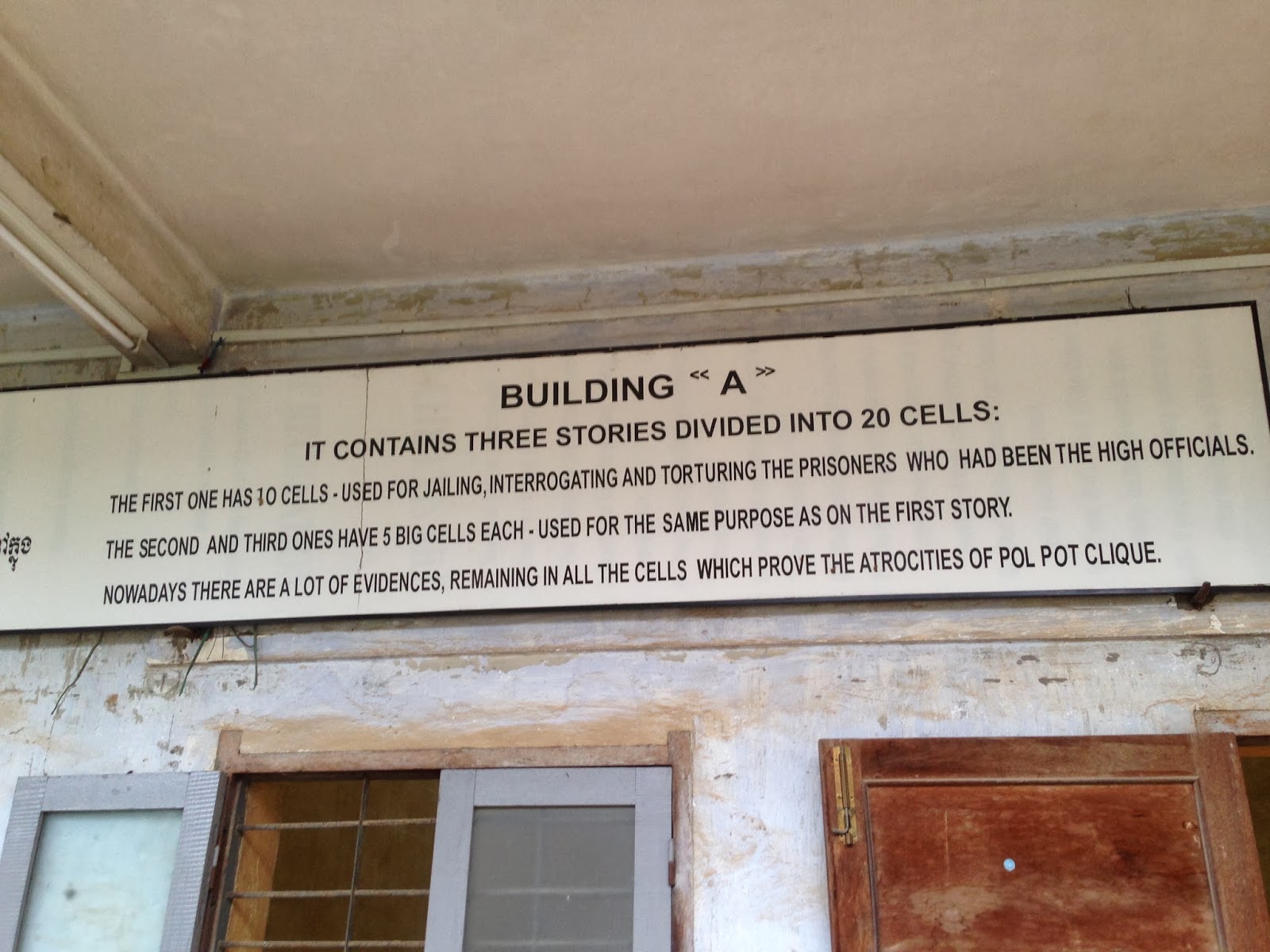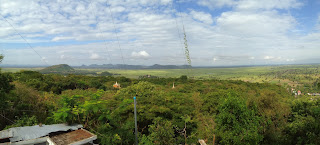This last post of our trip to Cambodia is probably not for the faint of heart. The images below and the things they represent are harsh and difficult to stomach. They will take you into the dark recent past of Cambodia when the Khmer Rouge, a revolutionary Communist/Maoist organization, instituted a reign of terror from April 1975 until neighboring Vietnam invaded and removed them from power in January of 1979. Under the Khmer Rouge and its infamous leader Pol Pot, some 1 to 2 million Cambodians (the numbers are difficult to confirm and estimates vary widely) died from murder, starvation, exhaustion, and neglect. These deaths came on top of a bloody civil war between government forces and the Khmer Rouge from 1970 to 1975 in which an estimated 10 percent of the population died from war-related causes. The civil war was fueled in no small part by the conflict in Vietnam, which spilled over into Cambodia in the form of massive US bombing raids and incursions by US, South Vietnamese, and North Vietnamese forces.
When the Khmer Rouge took over, it declared Year Zero and began trying to turn the country into an agrarian-based society. It was a radical and brutal campaign and turned the country upside down, shattering its culture and society to such an extent that it is still felt today. All the cities and towns, including the capital of Phnom Pehn and its three million inhabitants, were emptied. Everyone was sent to the countryside to virtual slave labor camps where they worked the fields or in massive civil construction projects. Pol Pot said, "Our strength is in the countryside, our weakness in the cities," adding that Phnom Penh had to be evacuated to foil plots "to overthrow our revolution." Symbols of the old society or western influence, such as banks and churches, were destroyed.
It also began a systematic campaign to "purify" the country and began eradicating people tied to the former society or whom they suspected could be a counterrevolutionary. Tens of thousands were murdered. Officials and soldiers of the previous government, teachers, intellectuals, Buddhist monks, landowners, store owners, doctors, or anyone deemed "elite" or suspected of association with foreigners (such as speaking English) were killed. Many were tortured first. Khmer Rouge officials identified the social backgrounds and status of the inhabitants of all the villages; those classed as rich or privileged lived under the threat of death. In many cases, entire families were killed because they owned more than one ox cart. People hid their backgrounds and made efforts to make themselves appear to be peasants. Ethnic minorities, particularly the Chinese, Thai, Vietnamese and Cham Muslims, were also persecuted and murdered in large numbers.
The reign of terror continued in the countryside. Those working in the fields or on construction projects could be murdered or starved for not working hard enough, complaining, or stealing food to boost their meager diets. No one wanted to hear one of the commonly-heard Khmer Rouge condemnation: "If you keep this man there is no profit; if he goes there is no loss."
In their effort to remake the society under a new ideology, the Khmer Rouge outlawed any show of "individualism," such as private ownership and garden plots. They also attacked the family structure by abolishing family names and limiting families to parents and their children under six. Older kids were sent to the fields. Our guide in Battambang told us his own brother and sister were sent off in this manner. Marriages were only by permission. Those who resisted these policies disappeared. Frighteningly, much of the enforcement of these policies and the murdering of those who did not comply was done by teenagers and young adults who dominated the ranks of the Khmer Rouge. The few survivors of the notorious prison called S-21 (which you will visit below) said a number of their jailers were teenagers, for example. They were the soldiers of the Khmer Rouge, manipulated by the leadership.
Typical of paranoid political movements and governments, the regime eventually began to eat away at itself. Members of the original cadre and local party leaders were increasingly accused as traitors and sent to prisons, such S-21, to be tortured and killed, their bodies dumped in the infamous "killing fields" that had sprung up around the country. Meanwhile, tensions along the border with Vietnam in 1978 led the Khmer
Rouge to accuse thousands of Cambodians living in what was called the
Eastern Zone to be disloyal. Whole villages were emptied, their
inhabitants taken to nearby fields and killed, sometimes with clubs.
It is a long and complicated story and that is just a snapshot of the horror. There are plenty of historical and personal accounts available on the reign of the Khmer Rouge if you're interested, plus one superb and unforgettable film from 1985, "The Killing Fields," which chronicled the story of an American reporter and his Cambodian assistant during the Khmer Rouge's takeover and the aftermath. The reign of the Khmer Rouge is a horrifying story, but an integral part of the history of Cambodia, and in our view, a must-see for visitors. The Cambodians are still dealing with it in their own way. Trials against those who participated in the genocide continue, but only against those at the senior leadership levels. Some former members of the Khmer Rouge are in the present government. Other lower-level Khmer Rouge members walk about today, untouched for the crimes they committed. Meanwhile, "genocide tourism" brings in much needed cash for the Cambodians from curious people like us.
Killing Caves of Phnom Sampeau
Not far from Battambang, there is a limestone outcropping with a complex of temples at the top. Part of the complex includes a building, now a shrine, once used by the Khmer Rouge to torture prisoners. On the same hill is a deep cavern that the Khmer Rouge threw prisoners into. If they survived the fall, they were left to starve. Our local guide said some 10,000 people died in the cavern. Today, there is a Buddhist shrine, which includes a macabre pile of skulls from the victims. A lonely attendant manages the site 24 hours a day.
 |
| Now adorned with colorful tributes, this building was once a torture facility. |
 |
| The cave. |

 |
| During our travels, we saw a number of sketches and paintings by eyewitnesses detailing the horrors of life under the Khmer Rouge. |
 |
| Russian-made artillery piece marking a former government position when they were battling the Khmer Rouge. |
Tuol Sleng (or S-21) Prison
The Khmer Rouge turned this former Phnom Penh high school into a headquarters for their security police and a detention, interrogation, and torture facility that they called S-21. Some 20,000 individuals were interned here; only
seven are known to have survived. The guards were still torturing and killing inmates in the final hours before Vietnamese forces captured the facility in 1979. The Vietnamese found and photographed the bodies when they entered the compound. Those gruesome photos are prominently displayed in the torture rooms where the individuals were found. These last 14 victims are buried on the compound. The rest had all been "disappeared" to the Choeung Ek Killing Field. The prison consisted largely of four buildings, one of which was used exclusively for interrogating and torturing prisoners. The others were used as holding facilities. Today, some of the rooms in the buildings are kept largely as they were. Blood stains are still on the floor of the rooms where the Vietnamese found the mutilated bodies of the last victims. The bed frames they were found on also remain, as are the makeshift holding facilities in the former classrooms of one of the school buildings.

 |
| Shackles and an ammo box that was used to hold the victim's legs apart while the interrogators did their gruesome work. |
 |
| Prison rules. |
 |
| The small field in the foreground contains the bodies of the 14 prisoners killed by the Khmer Rouge shortly before the Vietnamese entered the facility. |
 |
| The gallows. The prisoners were hung from the beam and dipped by the head into the water-filled containers. |
 |
| Room after room shows the photos of S-21's victims. Mostly men, but the photos also show a considerable number of women, children, and the elderly. Similar to the Nazis who managed the concentration camps of World War Two, S-21's administrators kept meticulous records, even going so far as to take photos of each prisoner upon entry to the facility. |
 |
| And many of the inmates in death as well. |
 |
| A few foreigners, including an American, were held at S-21 and killed. The bottom group of photos show an entire family, killed because the father was a railway engineer. Prisoners were interrogated and tortured into confessing of their crimes. Each was forced to make a written "confession." Many were accused of being spies for the CIA or the KGB and then tortured into writing confessions confirming their misdeeds. |
 |
| Wall of foreigners held at S-21 and their stories. H is reading through copies of their "confessions." All the personally-written "confessions" described their alleged lives as spies. One Brit was forced to confess that his family had worked for the CIA for generations. |
 |
| Holding cells in what were once classrooms. One survivor wrote that he could hear the screams of the tortured from his cell. "Screams were heard at all times. There was one kind of scream, the scream of terror, there was another kind of scream of asphyxiation near death." |
 |
| More holding cells. According to one of the few survivors, prisoners were not allowed to talk with one another or to sit in their cells. If they were not standing, they had to lie on the floor. |
 |
| Wire added outside the holding facility to keep inmates from jumping to their deaths. |
 |
| Torture instruments and paintings by one of the former inmates of torture methods. |
 |
| More instruments of torture. Someone had to explain the small boxes along the wall. They were for holding scorpions. |
 |
| Eyewitness painting of a mother forced to watch her baby killed before she is executed. There were many paintings such as these around the compound, all done by eyewitnesses. |
 |
| The last room. Full of paintings of torture, photos of the killing fields, a Buddhist shrine, and dozens of skulls, all with signs of head trauma. |
The Killing Field at Choeung Ek
Welcome to Cambodia's version of Gettysburg, Antietam, or Verdun. The difference being that here, no armies were shooting at each other and few shots were fired in anger.
Here, in what was once an orchard on the outskirts of Phnom Penh, some 20,000 individuals were executed and dumped into 129 identified communal pits. Nearly all were bludgeoned to death to avoid "wasting" bullets. In 1980, nearly 9,000 individuals from 88 of the pits were exhumed. They had all been blindfolded and their hands bound. Their skulls are on display in a prominent memorial on the grounds. Throughout the grounds, fragments of human bone, teeth, and bits of clothing still work their way up through the soil. We could not help but notice these along the trails. H noted that the place has changed significantly since she was last there about a decade ago. Then, it was not well-marked and bones lay scattered about all over. Now, the place is a peaceful park and moving memorial to the thousands who met their end there. Visitors of many nationalities quietly walk the paths and listen to an excellent audio tour, which includes a description of the site, stories from eyewitnesses, and a harrowing account by one of the executioners.

 |
| Memorial Stupa. Built in 1988, more than 8,000 skulls of the victims of Cheoung Ek are arranged by sex and age inside. |
 |
| Some of the pits of the killing field are covered and memorialized. 450 victims were exhumed from this particular pit. |
 |
| The field of pits reminded us of the World War One battlefield at Verdun, except the victims in each hole were not soldiers, but innocent civilians, and they did not die from bullets or shells, but from blunt trauma to the head. Each contained the remains of several hundred victims before they were exhumed in the 1980s. Bits of bone and pieces of clothing could still be seen in the dirt. |
 |
| Bound victims were marched up to each pit in lines of humanity, where each was struck with some sort of blunt instrument, the body falling into the pit to remain as they lay. Simple farm instruments were often used as killing tools. |
 |
| "The Magic Tree." The Khmer Rouge hung speakers from this tree, from which they blared patriotic music to drown out the sounds of the killings. |
 |
| At this site, as described by a survivor, women were forced to watch as their babies were smashed against the tree to the left. As soon as the baby was killed, the mother followed, her body then thrown into the pit. |
 |
| There is a museum at the site with a collection of photos, killing tools, and other items. This is a photo of Kang Guek Iev, "Comrade Duch," the infamous commandant of S-21. Eventually captured and put on trial, he was the only Khmer Rouge leader to show any remorse to the atrocities committed under their leadership. He said that the people who worked under him committed the acts, but he was responsible for their actions. He was sentenced to life in prison in 2012. |
 |
| Uniform of the Khmer Rouge. |
 |
| Plan of "Camp" Choeung Ek. There are more than 180 of these types of camps--the killing fields of Cambodia--scattered about the country. |
















































































